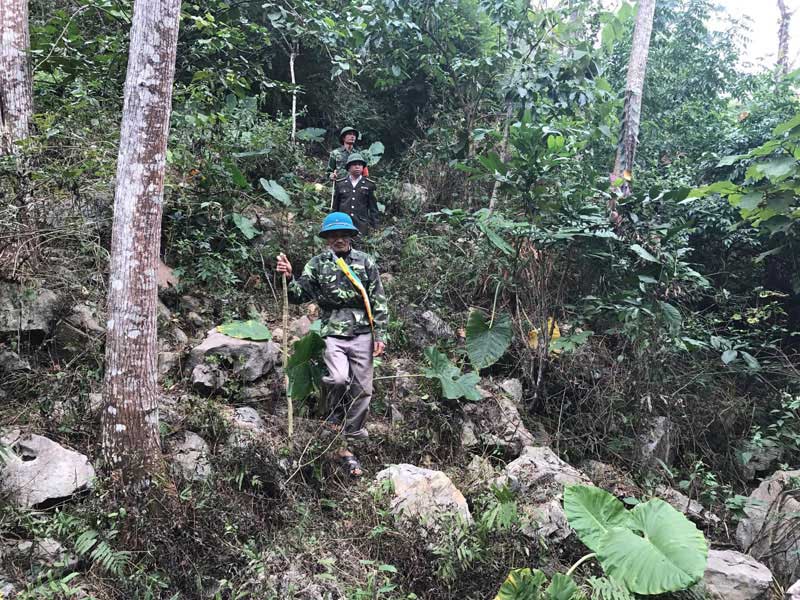
(HBO) – To proactively cope with extreme weather, especially the recent prolonged heat waves, Lac Son district’s forest ranger force has coordinated with relevant agencies to well implement regulations on forest protection and management and prevention of forest fire.
In the first half of 2018, the district’s forests have been protected with no violations recorded.

Lac
Son district’s forest rangers and the forest guard team of the district’s Tu Do
commune have held regular patrols.
The district’s forest rangers have tightened monitoring of local
forests and paid special attention to protecting the core forest areas and
preventing forest fire.
They have also worked with local authorities and agencies to hold
educational activities to raise awareness of regulations on forest protection
and development among individuals and organisations.
During the first 6 months of this year, the Lac Son forest
protection bureau has provided training on forest and forestry-related
regulations for over 3,800 people in the district. In addition, they have
cooperated with local media agencies to publish news on local activities to
protect and expand forests and produce forestry products. The bureau also encouraged
local people to develop forest-based economic activities, thus reducing poverty
and contributing to local efforts of building new-style rural areas.
The local forest ranger force, police and military command have
together adopted a mechanism for coordination in maintaining social order and
security in the district. The forces also built a plan on conducting joint combat
drills combined with forest fire fighting across the district’s communes and
towns.
The forest rangers have conducted regular inspections of forestation
activities in the province and shared experience in forest management.
Furthermore, they have partnered with local judicial body to
promptly settle forest land-related disputes and complaints in the communes of
Lien Vu, Binh Hem and Yen Phu and cooperated with forest rangers of
Cuc
Phuong
National Park and Pu
Luong Nature Reserve in management and protection of forests in contiguous
areas.
Some 360 forest guard teams, comprising of 1,500 members, have
been set up at 29 communes and townships in Lad Son district. The forest
rangers have collaborated with the local administrations to guide local people
on how to proper clear land for farming and prevent fire from spreading to the
forest. They also regularly clean up dead plants and maintain anti-fire
corridor in high-risk areas. Local people have been also urged to keep fire
fighting equipment in their homes.
According to data from the Hoa Binh Provincial Party Committee, the industrial production index for the first six months of 2025 is estimated to have increased by 20% compared to the same period last year. This marks the highest year-on-year growth rate for this period since 2020.
In the first six months of 2025, Hoa Binh province’s export turnover was estimated at 1.145 billion USD, marking an 18.11% increase compared to the same period in 2024. Import turnover was estimated at $ 804 million, a 17.15% increase, which helped the province maintain a positive trade balance.
The lives of the ethnic minority farmers in Tan Lac district have gradually improved thanks to the new directions in agricultural production. This is a testament to the collective strength fostered through the professional associations and groups implemented by various levels of the district’s Farmers’ Union.
With the motto the "product quality comes first,” after nearly one year of establishment and operation, Muong village’s Clean Food Agricultural and Commercial Cooperative, located in Cau Hamlet, Hung Son Commune (Kim Boi district), has launched reputable, high-quality agricultural products to the market that are well-received by consumers. The products such as Muong village’s pork sausage, salt-cured chicken, and salt-cured pork hocks have gradually carved out a place in the market and they are on the path to obtaining the OCOP certification.
In the past, the phrase "bumper harvest, rock-bottom prices" was a familiar refrain for Vietnamese farmers engaged in fragmented, small-scale agriculture. But today, a new spirit is emerging across rural areas of Hoa Binh province - one of collaboration, organisation, and collective economic models that provide a stable foundation for production.
Maintaining growing area codes and packing facility codes in accordance with regulations is a mandatory requirement for agricultural products to be eligible for export. Recently, the Department of Agriculture and Environment of Hoa Binh province has intensified technical supervision of designated farming areas and packing facilities to safeguard the "green passport" that enables its products to access international markets.



